31 Days, 31 Lists: 2022 Nonfiction Books for Older Readers

Okay. Same drill as yesterday, just a touch older. As I mentioned before, you’re going to see a lot of books on today’s list that you’ve already seen on some of the previous lists (the Gross list, the Photography list, the Science list, etc.). And you’re also going to find a couple titles on here that haven’t been on any lists at all yet because they don’t slot neatly into my other categories. One thing you will definitely find here, though, are my favorite reads for older kids in 2022, if those kids happen to be into nonfiction and informational books. These are lean, mean, fact-spouting machines and they are perfect for fact-loving kids.
Interested in similar titles? Check out the Older Nonfiction lists of years past:
2022 Nonfiction Books for Older Readers
American Murderer: The Parasite That Haunted the South by Gail Jarrow
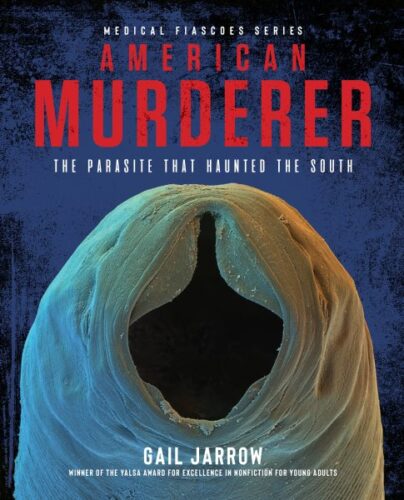
A face only a mother could love?

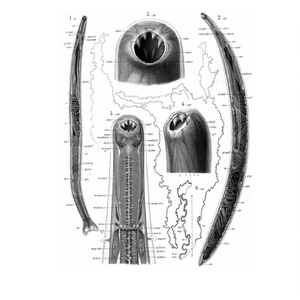
Hoo boy! I’ll be seeing this one in my dreams tonight! And the crazy thing is, I didn’t even post the grossest picture here (read the book and see if you can figure out which pic I mean).
ADVERTISEMENT
ADVERTISEMENT
I’ve mentioned before that my library has an unofficial rule that when we create our annual 101 Great Books for Kids list there should be at least one seriously gross book on the list in some way? Gross isn’t for everyone but when you find a good one, you hold it close (metaphorically). Now we were considering both this book, American Murderer, and Packing for Mars for Kids, each gross in their own unique ways (and both for kids between the ages of 9-12). Ultimately, this was the book that stole our hearts. Why? Because, and I mean this truly my friends, it is terrifying. Imagine me running around the home, thrusting this book into the face of my 3rd grader to show him the terrifyingly toothy hookworm photos inside (I is best mom). And this is the best book. It really explains perfectly how the American South was effectively crushed for generations by a hookworm named, and this is true, the American Murderer. This is part of the Calkins Creek “Medical Fiascoes” series, and is the first I’ve had a chance to read myself, though I’ve always been a big Jarrow fan. Full of disgusting and fascinating photos and images, a certain strand of kid is going to find this enthralling. Worms worms worms!
Before Music: Where Instruments Come From by Annette Bay Pimentel, ill. Madison Safer
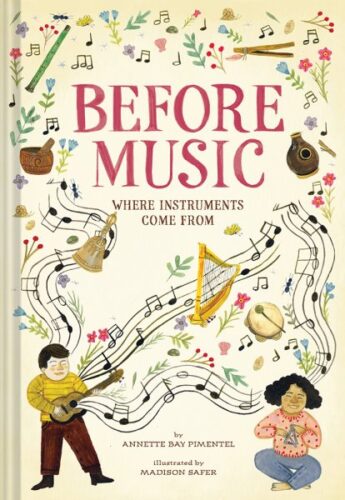
Music from rocks. Music from shells. Music from seed pods, cocoons, and ore. Come see a fantastic array of worldwide instruments, many of which you will have NEVER heard of before. You know, I worry that had I known what kind of book Before Music was prior to picking it up, I might have avoided it. I’m a little tired of nonfiction titles for kids that are just lists of things. Collected bios or endangered animals or what have you. Usually a book that is full of lists is, to be perfectly frank, rather dull. I know that our expository readers like them, but surely there are adept ways to make them, right? That’s where Pimentel comes in. Before Music is this exceedingly clever look at the origins of instruments based on what they’re made out of (stone, clay, gourd, silk, metal, bamboo, wood, and skin). But what I love about it is that you get to see so many new and interesting instruments. I didn’t even know I was into instruments I’d never encountered before, prior to reading this book. What a hoot!
Buzzkill: A Wild Wander Through the Weird and Threatened World of Bugs by Brenna Maloney, ill. Dave Mottram
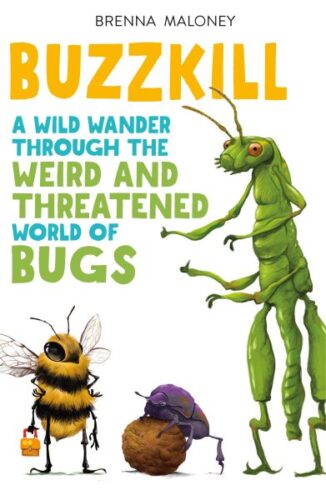
I came this close to missing this book. It was only through the intervention of a friend (and well-respected author) that it even came to my attention. Without revealing this friend’s identity, this person is a much better writer than I will ever be and so I put to you a small portion of the recommendation that convinced me to pick this up:
“She’s [Maloney] not only a very funny writer, doing a kind of stand-up about insects (she’s a big researcher) but she’s an incredibly elegant one with metaphors. For example, she talks about the noise cicadas make and she describes the process as being very like the way you make noise expanding and contracting a bendy straw. What kid hasn’t made that bendy-straw noise? When she talks about molting, she explains that the new exoskeleton has to be bigger than the old one, so it’s like having a heavy winter coat underneath a thin, sweat-soaked tee shirt—you have to peel off that tee-shirt very carefully, and lots of times a leg gets torn off in the process. Everything is explained with the utmost clarity, as if she were standing by your elbow.”
The book itself is a whopper, clocking in at a whopping 378 pages. Your kids will read every word. So it is gross? And how! Whether Brenna Maloney is eating mealworms (not crickets, though), talking about eyelash mites, discussing the loudest animal in the world (the water boatman bug that makes the sound by hitting its penis against its abdomen), or what have you, disgusting details abound and are so funny and so smart. I freakin’ love this book. Bugs, man. Who knew?
Fashion Forward: Striving for Sustainable Style by Raina DeLisle

Go behind the glitz and glamor of the fashion industry to explore a little more deeply the social and environmental implications that come with your latest pair of shoes. It took me a little while to get into this one (this Orca Footprints series really needs an upgrade in the design department) but once I was then it really gave me a lot to sit and think deeply about. It’s funny how rarely one considers the clothes you buy and toss so casually. I was particularly impressed by the number of resources, brands, and times that the book finds ways to get kids directly involved. And it also makes me awfully happy that I used to buy my daughter Princess Awesome dresses back in the day. Who knew they were so sustainable?
The 500 Million Dollar Heist (The Unsolved Case Files) by Tom Sullivan
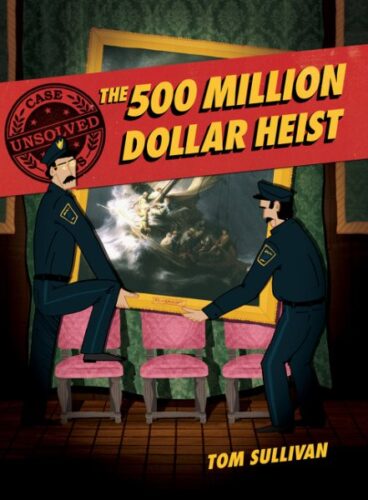
Now, from the moment I read the first book in the “Unsolved Case Files” series (Escape at 10,000 Feet), I was hooked. I was also a little puzzled. How is it that no one has ever thought to do what Tom Sullivan has done? Which is to say, lay out the facts of various unsolved crime-related mysteries, and allow the child readers to decide the truth. Each book in the series looks like a series of documents, but laid out in a narrative format. The crime is described first and then the reader is told what we now know. After that, different theories are posited, as well as those complications that make one theory or another more or less likely. Since reading this book about the robbing of the Isabella Stewart Gardner Museum I’ve seen references to it everywhere. And maybe at some point in my past I’d heard of the famous art heist that was never solved, but Sullivan really puts you inside the action from the get go. You are there when the crime is discovered. You are there as you see it in progress. And you are no closer to solving the case than anyone else by the end. Kids of a certain mindset will greatly enjoy debating the possible solutions to the case with their friends. As delightful as the crime was infuriating.
Hardcourt: Stories from 75 Years of the National Basketball Association by Fred Bowen, ill. James E. Ransome
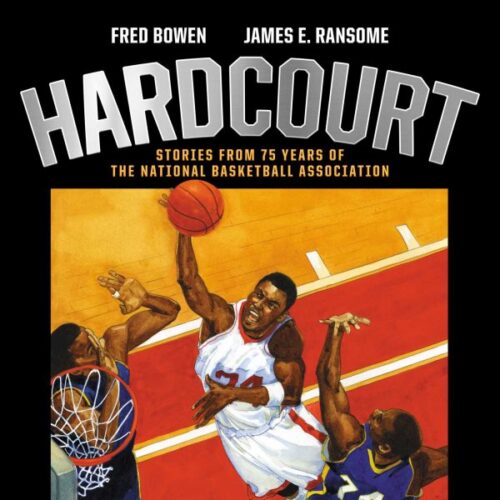
This book? It’s all about the personalities, rivalries, and moments of sheer remarkable physicality. All the drama is on display in this quick synopsis of its history and greatest moments, with stunning watercolors that capture the soul of the game. Boy, I tell you. Ebooks may have their uses but there is no comparison to a print title when it’s as large and lovely as this one. I read the book on my phone but seeing the actual book in person I realize now how much you lose when Ransome’s art gets shrunk to a pinprick. I pretty much don’t know anything about basketball so for me this book was like getting a crash course with a LOT of explanations. I feel like I now can get a whole host of cultural references I would have missed in the past. And really, isn’t that sort of the point of children’s nonfiction? To catch kids up on the rest of the world that already happened? Gorgeous and engaging and something some of our child readers are going to want to see the most.
Honeybee Rescue: A Backyard Drama by Loree Griffin Burns, photos by Ellen Harasimowicz
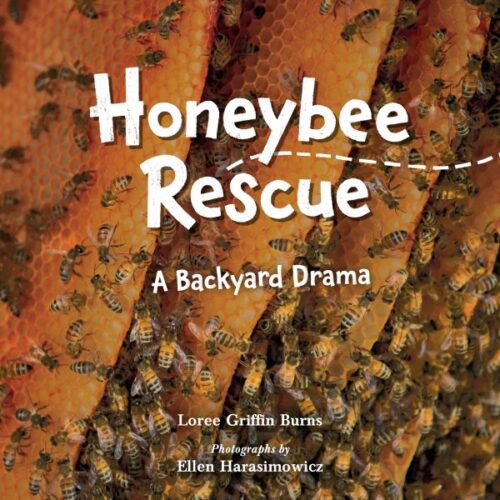
Uh-oh. Bees have moved into a rickety old barn. Who will move them to a safe spot before the winter? It’s Mr. Nelson, the bee rescuer! An informative and fun look at finding honeybees a brand new home. How much do I love this slightly older nonfiction book? Let me count the ways. I’ve heard of relocating hives of bees before but I always thought it just happened when homeowners found them to be nuisances or something. This is such a meticulous and fascinating encapsulation of the process. Honestly, you could probably sell it on the basis of the gentle bee vacuum alone. And I have the same reaction to seeing Jon Nelson handle live bees with his bare hands as I do to watching someone free solo. Which is to say: abject terror. Burns outdoes herself. This should be in every library
How to Build a Human in Seven Evolutionary Steps by Pamela S. Turner, ill. John Gurche
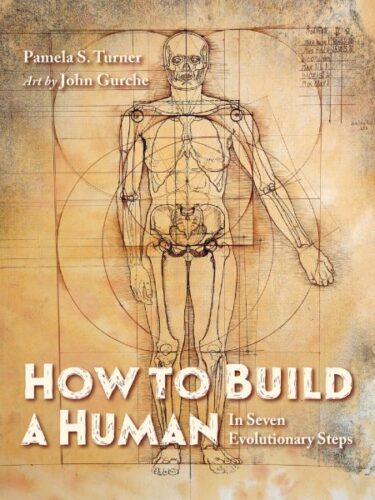
How do you make a human? How many “cousins” on our family tree were there? The mysteries of evolution abound in this funny, fascinating, and completely up-to-date deep dive into humanity’s origins. Well, this is very much my jam, and it did not disappoint. I read a Goodreads review of this where a librarian was lamenting the fact that they’d had to weed their copy of Lucy Long Ago because it came out in 2009 and the information was now out-of-date. This book, she crowed, was a perfect updated edition of very much the same information. Better, I’d say. I loved Lucy but this gives such a loving look at the full swath of ancient ancestors that were out there. Plus, Turner has this amazing sense of humor. Hope you like snarky footnotes because this title delivers! The art by John Gurche is particularly nice. I’m still a bit floored by the fact that an Erectus guy like Nariokotome Boy was full grown at the age of 8. So many facts! And finally, that Author’s Note on the end on race is so needed and so necessary. Incredible.
I Begin With Spring: The Life and Seasons of Henry David Thoreau by Julie Dunlap, ill. Megan Elizabeth Baratta
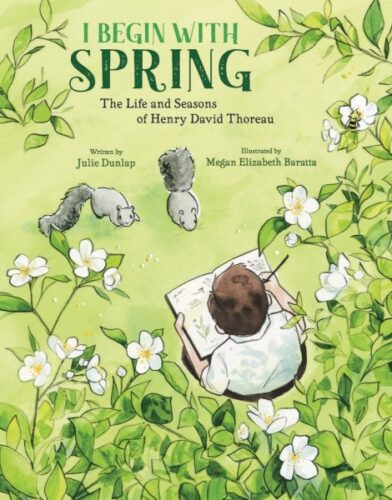
How can one man living in a cabin in the woods make any kind of a difference? The life and writings of Thoreau are explored in a playful, engaging notebook of a book, showing his influence both then and on people today. This is a dive into the life of Henry David Thoreau, but told in such a way as if you were you reading through one of his journals. There’s a running timeline on the bottom of the pages as the seasons pass, noting when the first bank swallow is seen or when he collected white pine cones. It makes a pretty strong case not simply for why David’s life was important (civil disobedience and his vehement dislike of slavery are cited multiple times) but also his more scientific work. I found the backmatter on how current climate change scientists are able to use his meticulous notes on nature to track climate change to be fascinating. I do wish there had been some mention of the fact that yeah, he lived in the woods but his mom did all his laundry, but all told it’s a strong piece with some killer backmatter. A must read!
Killer Underwear Invasion! How to Spot Fake News, Disinformation & Conspiracy Theories by Elise Gravel
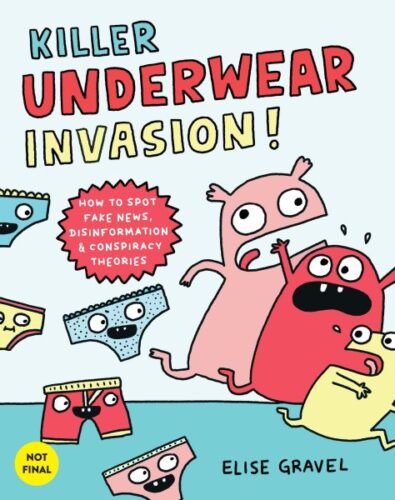
How do you know what to believe when you read something online? Using the fake report that underwear can kill you, this book breaks down all the different ways that you can figure out if news is real or not. You know, at a certain point a person begins to wonder why no one else is doing what Elise Gravel is doing. This isn’t to say that there aren’t other people making books about fake news and conspiracy theories. It’s just that they’re… well… not half as interesting as this book is. And who better to shine a light on the sheer idiocy of fake news than a children’s book creator? This should be required reading in every school and public library in the nation. Seriously! The information in here is invaluable and, let’s face it, the fact that we aren’t teaching this in schools is a crime in and of itself. This isn’t just good. This isn’t just funny. This is imperative.
A Leopard Diary: My Journey Into the Hidden World of a Mother and Her Cubs by Suzi Eszterhas
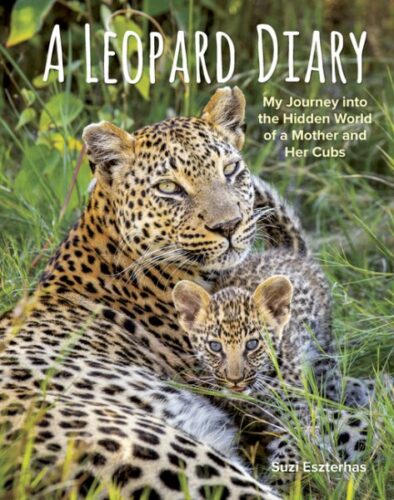
Did you ever wonder about the sheer amount of work that sometimes goes into the creation of a book? As I read through Suzi Eszterhas’s work traveling to and from Botswana, tracking leopards (noted as being “famously shy”) so as to photograph them at a very young age (also hard to do), I decided that there must have been multiple reasons for this beyond the book. As it stands, however, A Leopard Diary is an incredibly impressive title! It’s also a great process title. You really get to see how much work it takes to keep tabs on leopards and care for them from afar. Written in a diary format, the book is just packed full of photos and facts. Almost as important? The design of the whole thing is fun and accessible. Though the text is for older readers, it’s just 40 pages long, so it doesn’t scare you off with its size. Big cat loving kids will just eat this up too cause this thing is packed full of baby leopards of various sizes. Baby leopards, people! Are you made of stone!?
Operation Pangolin: Saving the World’s Only Scaled Mammal by Suzi Eszterhas
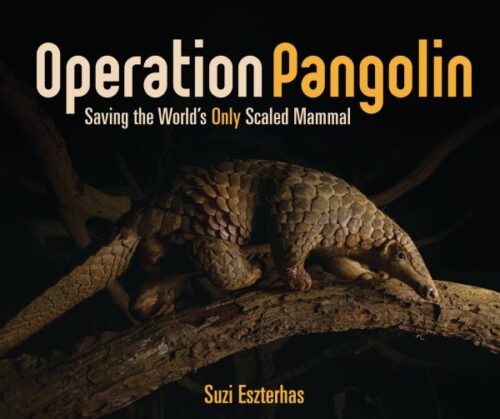
Shy creatures make for great nonfiction. Particularly when their books are the perfect length and the perfect ratio of text to image. If I’m a kid who has to do a report on pangolins, or simply heard of them and got interested (they were certainly in the news a lot at the beginning of the pandemic) then I would want to see a LOT of photographs of them in a book. Some nonfiction for older kids limits how many images they can include. Credit Millbrook Press then for committing to the bit and just filling page after page in this title with pangolins galore. Clocking in at a mere 40 pages (so it never feels overwhelming, but also never feels like a picture book) Eszterhas lays out the information perfectly. You meet Thai Van Nguyen, one of the very few pangolin researchers in the world, right at the start. Then you learn about the animals, you learn about how Thai and others are educating people on pangolins, and there’s a great section at the end on how kids can help (always a plus). By the end you won’t just be vowing never to eat the critters. You’ll be vowing to single-handedly save them yourself! A marvelous example of older nonfiction that won’t scare off the informational text newbies.
Packing for Mars for Kids by Mary Roach
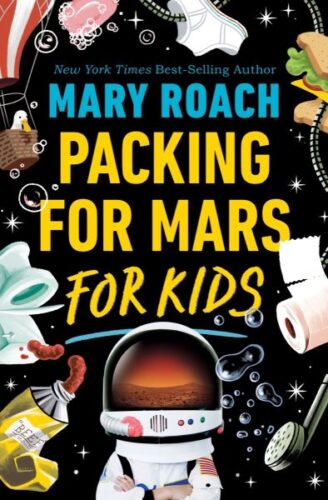
Did you know that a human body never feels like it has to pee in zero gravity? Did you know that showers don’t work in space? Or that after a couple weeks your nose stops noticing bad body odors? Join Mary Roach for the grossest trip to the stars you will ever EVER encounter. Folks, I don’t want to overhype this, but I think this may well be the grossest nonfiction book for kids I have ever read in my life. You know all those books on poop and snot and what have you? None of them can hold a candle to this. Now generally I dislike Young Reader’s Editions of any adult titles, but Roach’s original book (Packing for Mars: The Curious Science of Life in the Void) came out in 2010. I’d say 12 years is about the right amount of time to get a younger version right. I do desperately wish they’d renamed it, though. Though the book is about life in space, there’s almost no mention of Mars itself until then end, so Mars-hungry kids are going to be pretty disappointed. Also, this book takes about three chapters to really get going. The first two are fine, but I did think about stopping more than once. Then we started talking toilets and everything got really crazy, really fast. I learned so much that I can never unlearn. Let’s just say the section on fecal bags may have scarred me for life. A winner!
Save the People: Halting Human Extinction by Stacy McAnulty, ill. Nicole Miles
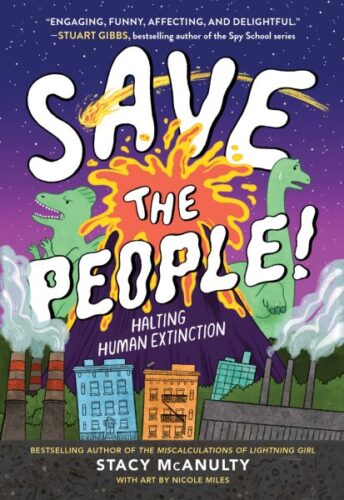
Mass extinction! For kids! And it’s funny! What are all the different ways extinctions have happened in the past and what are the possible ways humans could disappear in the future? A remarkably hilarious look at mass destruction. This is an ideal book for the kind of kid obsessed with all the different ways the human race could go belly up. Failing that, it’s a book for the kid who comes to your desk asking for Titanic/Donner Dinner Party/etc. titles. The catastrophe kid. And believe me, there are a lot of kids out there like that. While I wouldn’t necessarily hand it to an anxious kid, McAnulty’s latest magnum opus really handles its dire material in as enjoyable a way as possible. I had no idea that volcanoes were much more dire than asteroids when it comes to the possible destruction of humanity. Let’s hope that Stacy McAnulty does a lot more nonfiction in the future. Sole downside? I cannot read this title without getting the Godspell song “God Save the People” caught in my head. Every. Single. Time.
Seen and Unseen: What Dorothea Lange, Toyo Miyatake, and Ansel’s Adams’s Photographs Reveal About the Japanese American Incarceration by Elizabeth Patridge, ill. Lauren Tamaki
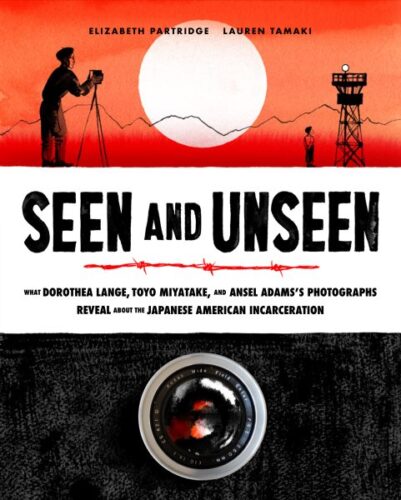
ADVERTISEMENT
ADVERTISEMENT
When your country makes a horrible mistake, how do you document that failure? Three great photographers saw the internment of Japanese American during WWII from different angles. Look through their eyes and determine where the truth lies, and where the lies start to sound like the truth. Expertly woven together. Though I’d place this in the older nonfiction section, the actual text of this book is relatively short and to the point. Partridge is economic with her wordcount here. You really get a very essential, if fast, rundown of the history of Japanese American incarceration. The lens of the book (if you’ll forgive the pun) focuses squarely on the three photographers and the different ways they portrayed the concentration camps for the greater American public. Lange wanted to show them honestly, but the government censored her images. Miyatake couldn’t show his at all, so took them in secret and kept them intact for years. And Adams wanted to show the residents of the camps in the best possible light, even if that was ultimately detrimental to the greater good. The text and use of the photographs is great, but it was genius bringing in Tamaki to fill in the gaps with illustrations. The end result never flags in interest at any point. And, as a Photography major in college myself, I love how it shows the nuance between photojournalists trying to tell the truth to the world and the ways in which that “truth” can ultimately be manipulated. Heady stuff.
Star Child: A Biographical Constellation of Octavia Estelle Butler by Ibi Zoboi
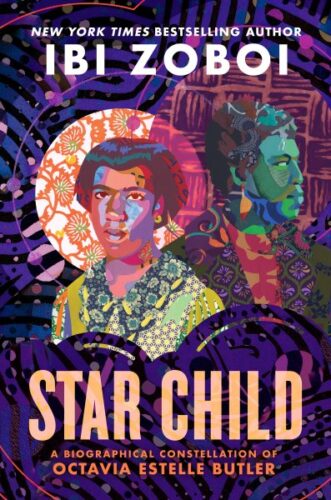
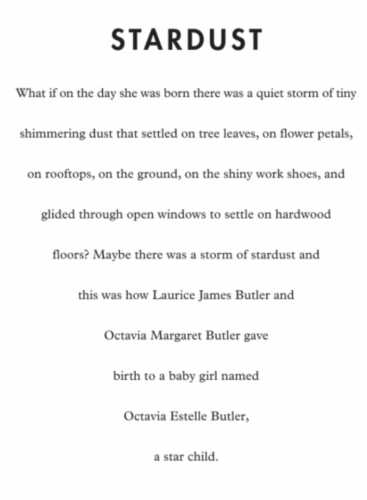
With vivid poems and engaging mini-chapters, Zoboi offers a cosmic look at the legendary science fiction writer’s youth and the events that inspired her to create such otherworldly stories. This is great! I checked out a copy from the library and loved everything about it. There are facts about Octavia’s life in here but it’s also just chock full of poems. But what really came through to me throughout the book was just how real Octavia was as a person. Taking archery so that she wouldn’t have to deal with other people? I felt that. A pity she never wrote anything for kids, but who cares? This is some really cool stuff and I want it on every list that there is!
The Waiting Place: When Home is Lost and a New One Not Yet Found by Dina Nayeri, photography by Anna Bosch Miralpeix
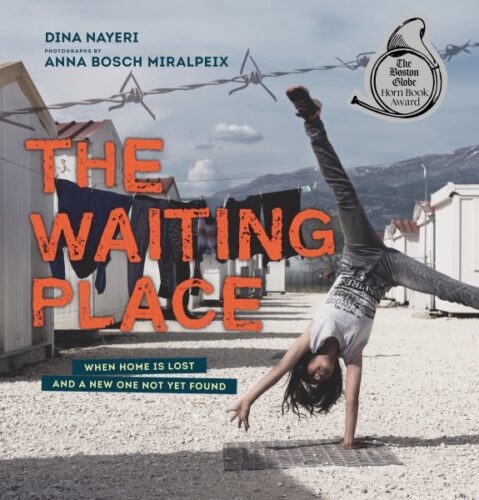
The Waiting Place wants everyone in it to stay. Meet the children who fight back against the interminable boredom and tension of living in a refugee camp, refusing to be forgotten by the rest of the world. Welp, that just about killed me. So this would be Dina Nayeri, sister of fellow author Daniel Nayeri. She’s also the author of the very adult The Ungrateful Refugee, which got great reviews a year or two ago. Her challenge here is how to show kids defying the hopelessness of the Katsikas refugee camp outside of Ioannina, Greece. That cover is probably the smartest thing I’ve seen in a while, since it perfectly sums this book up. Now Dina’s taken the tricky method of giving the camp itself intention. I think it works overall. If we’re looking for books that help kids build empathy, I can think of few quite as powerful as this one. And, naturally, I love any book that knows how to use photography and use it well. Like nothing you’ve read before.
The World’s Most Ridiculous Animals by Philip Bunting
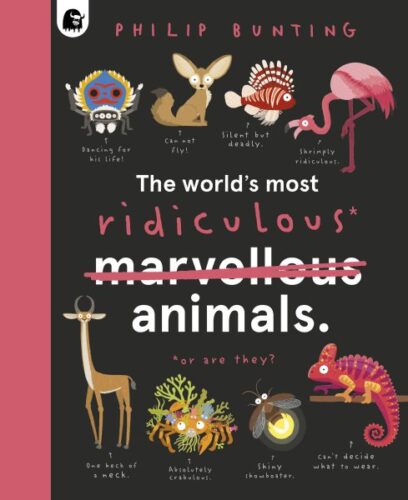
It’s as if Philip Bunting said to himself, “To please Betsy this year, I shall include an entry into my World’s Most series that contains not one but TWO Simpsons references on the same page!” I’m not even kidding. Check out the entry on tardigrades if you don’t believe. Now I included a Philip Bunting book on a previous year’s list as well (in that case it was The World’s Most Pointless Animals) and I was gratified to see that that book must have sold pretty well since Happy Yak tapped the man to write another in the same vein. Here the only impetus is for these creatures to be interesting. As such you’ll get gross critters like the zombie snail and strangely pretty ones like the ribbon eel. Guaranteed you’ll learn something from this, plus the joke density is fairly high. Even if you don’t know The Simpsons (in which case, how are we even friends?) you’ll find a lot to laugh at here.
Want to see other lists? Stay tuned for the rest this month!
December 1 – Great Board Books
December 2 – Picture Book Readalouds
December 3 – Simple Picture Book Texts
December 4 – Transcendent Holiday Picture Books
December 5 – Rhyming Picture Books
December 6 – Funny Picture Books
December 7 – CaldeNotts
December 8 – Picture Book Reprints
December 9 – Math Books for Kids
December 10 – Gross Books
December 11 – Books with a Message
December 12 – Fabulous Photography
December 13 – Translated Picture Books
December 14 – Fairy Tales / Folktales / Religious Tales
December 15 – Wordless Picture Books
December 16 – Poetry Books
December 17 – Unconventional Children’s Books
December 18 – Easy Books & Early Chapter Books
December 19 – Comics & Graphic Novels
December 20 – Older Funny Books
December 21 – Science Fiction Books
December 22 – Fantasy Books
December 23 – Informational Fiction
December 24 – American History
December 25 – Science & Nature Books
December 26 – Unique Biographies
December 27 – Nonfiction Picture Books
December 28 – Nonfiction Books for Older Readers
December 29 – Best Audiobooks for Kids
December 30 – Middle Grade Novels
December 31 – Picture Books
Filed under: 31 Days 31 Lists, Best Books, Best Books of 2022
About Betsy Bird
Betsy Bird is currently the Collection Development Manager of the Evanston Public Library system and a former Materials Specialist for New York Public Library. She has served on Newbery, written for Horn Book, and has done other lovely little things that she'd love to tell you about but that she's sure you'd find more interesting to hear of in person. Her opinions are her own and do not reflect those of EPL, SLJ, or any of the other acronyms you might be able to name. Follow her on Twitter: @fuseeight.
ADVERTISEMENT
ADVERTISEMENT
SLJ Blog Network
Happy Poem in Your Pocket Day!
More Geronimo Stilton Graphic Novels Coming from Papercutz | News
Parsing Religion in Public Schools
Environmental Mystery for Middle Grade Readers, a guest post by Rae Chalmers
ADVERTISEMENT







